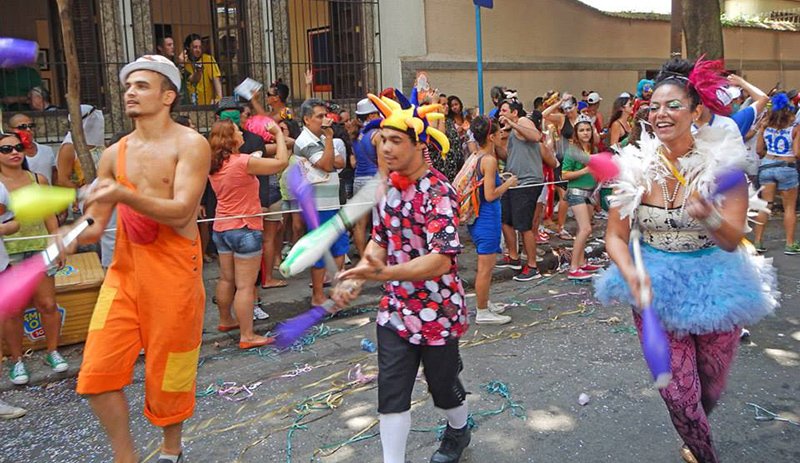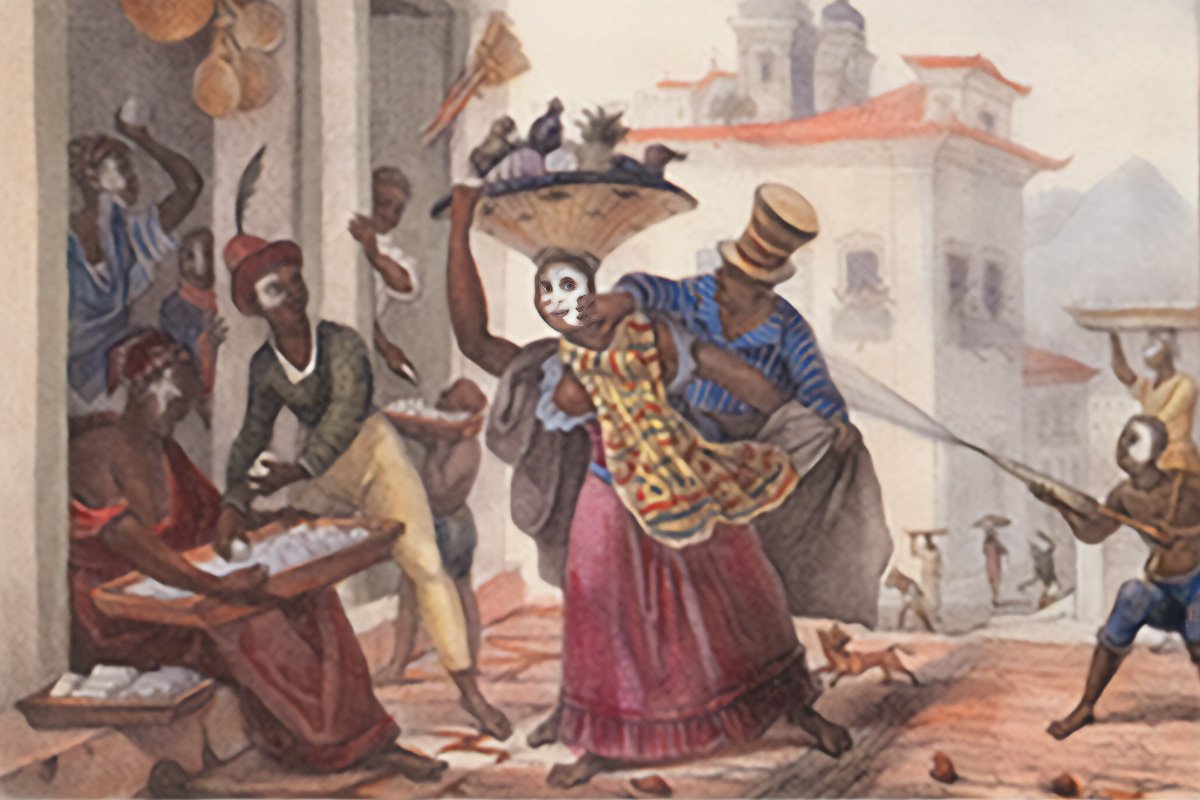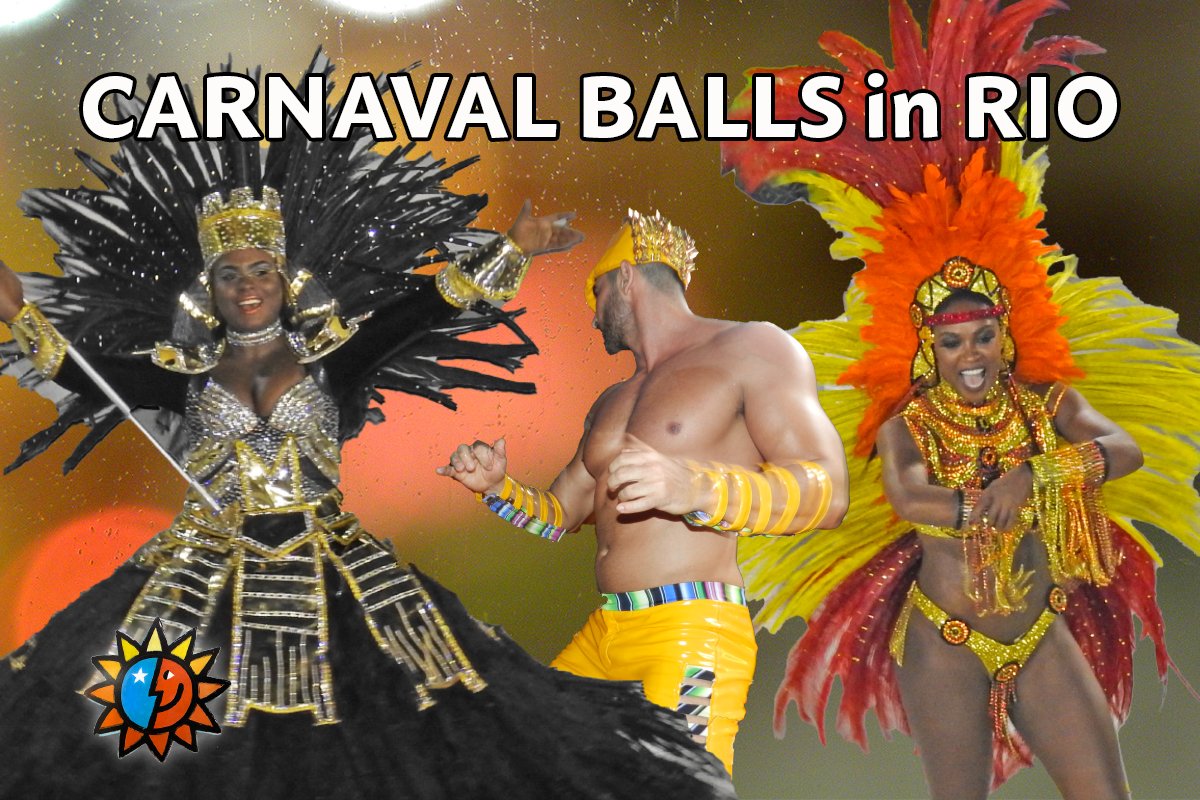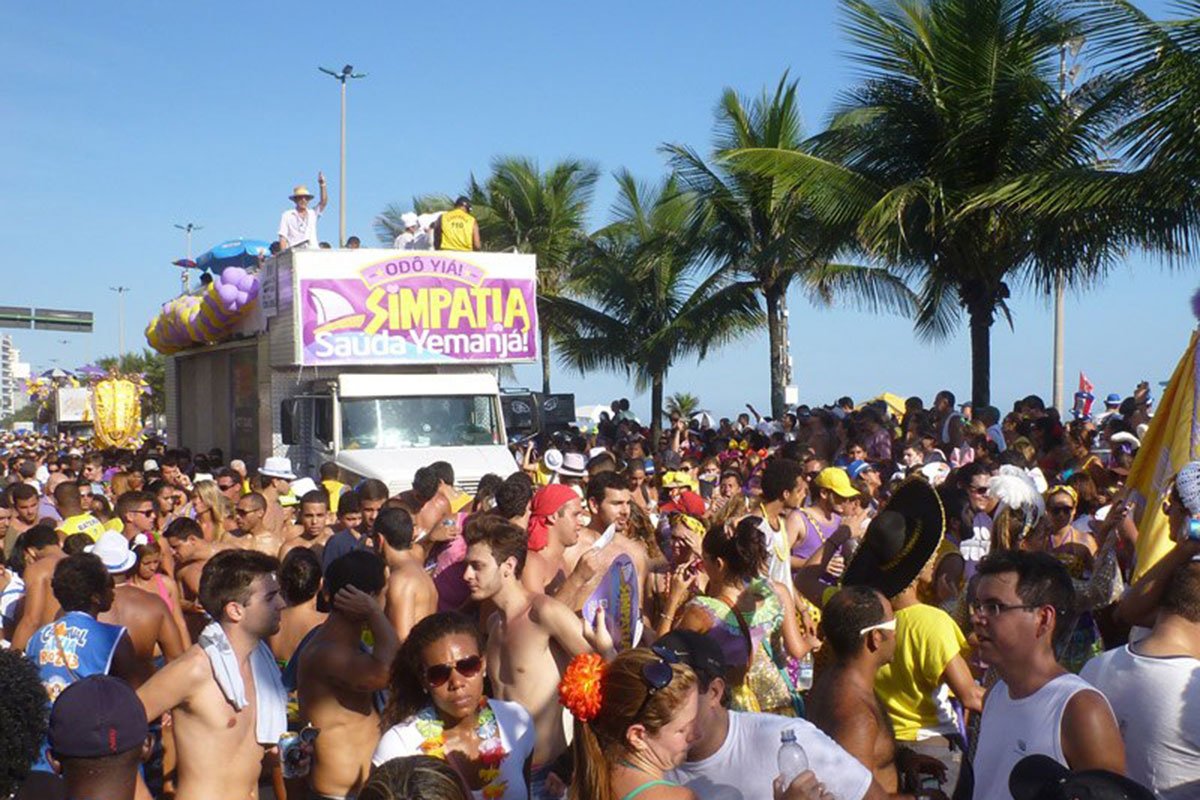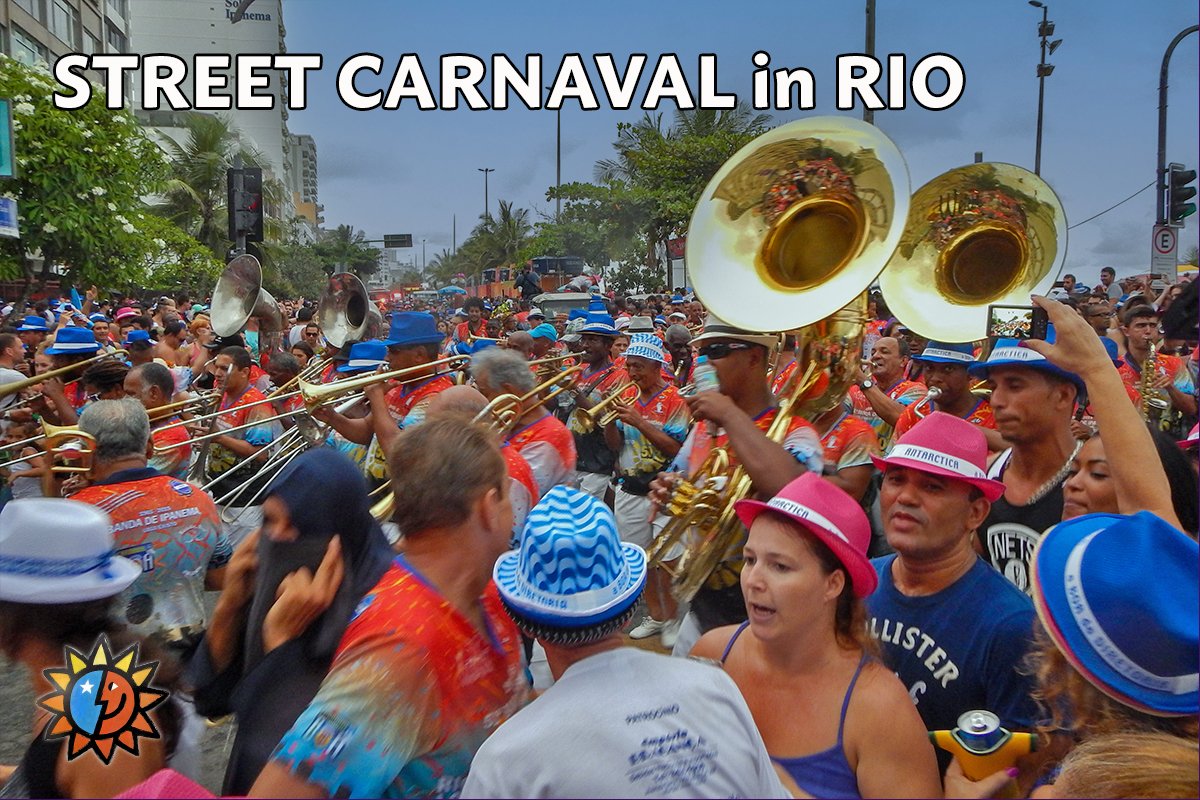
Street Carnaval in Rio
They may try to organize, glamorize, televise, or even industrialize it. Yet, Carnaval is a genuine part of the city culture. It is deeply ingrained in the fun-loving Carioca soul. Street festivities are open and spontaneous. Everybody's welcome to participate! Find our selection of the best Blocos and Bandas at the Carnaval Party Planner and Pre-Carnaval in Rio.
Back in the colonial era, while the confetti battles in France were epic, in Rio, most of the fun involved throwing liquids at other people. This was the Entrudo. If you were fancy, you stocked up on limões de cheiro (water limes). These were balls made of wax and filled with a pleasant-smelling citrusy liquid. Those who could not afford the investment improvised and allegedly may have added other 'spices' to the mix (more in History of Carnaval in Rio).

Bandas & Blocos
Street festivities were gradually exposed to a healthy dose of Brazilian colors and flavors. Our Street Carnaval parties are typically Carioca. The concept of a Bloco includes a percussion band marching along a pre-determined route, followed by hordes of enthusiastic revelers. They may come dressed in costumes, plain clothes, special T-shirts, bathing suits, or even in drag.
There are about 500 Blocos in Rio in all formats and sizes. Each Bloco must request permission from the city government to parade in a particular area during a specified day and hour. They try to assemble this jigsaw puzzle and, typically, only publish the official list a few weeks ahead. The city installs restrooms, chemical toilets, and fences around street gardens to protect them
While the city offers security, helps with the infrastructure, and controls traffic, Blocos are not financed by the government. To help cover costs, they try to find sponsors, promote events and rehearsals in clubs, and sell T-shirts. It's always a struggle, yet each Bloco is powered by a group of devoted Cariocas who are proud of their culture and heritage.
Some blocos became household names and even perform in other states. Others remained small or moved their dates to the pre-Carnaval period. All Cariocas have their favorite ones, and if you can join a group, you're all set! Although there's no clear line to differentiate, there are themed, neighborhood, and mega-Blocos to choose from. Mix and match.

Megablocos
Megablocos, by definition, are huge. Some attract as many as a million people. They happen in Centro, usually on Rua Primeiro de Março. Cordão da Bola Preta is the first to come to mind, as they have been around for over 100 years! Monobloco, which happens on Sunday after the Champions' Parade, is another giant.

Another favorite area for larger Blocos is the gorgeous Flamengo Reclaim Park. It sprawls over a large open area along Guanabara Bay close to Centro, with a view to the Sugarloaf and the Corcovado. The park was designed by modernist Affonso Reidy, and the gardens are signed by celebrated landscape designer Roberto Burle Marx, another world reference.

Neighborhood Blocos
Moving on to neighborhood Blocos, these are typically created by friends who love their 'bairro' and Carnaval. They may remain stationary or follow a pre-determined route. These events welcome revelers from all over town, and the typical soundtrack is composed of songs that everyone can sing along to. The percussion band performs Carnaval classics, marchinhas, and memorable sambas.
Larger Blocos, such as Simpatia é Quase Amor in Ipanema, attract as many as 200,000 revelers! Each year, they compose a new theme song that everyone is supposed to learn and sing along. Later, they play the traditional repertoire. Vocalists stay on top of a sound truck, followed by the percussion band, with thousands upon thousands of people dancing ahead and behind.
Banda de Ipanema, one of the most celebrated, does not have interpreters. The percussion band plays favorite Carnaval classics while revelers sing along. When they pass by Igreja Nossa Senhora da Paz, they stop for a moment of silence and then play the song Carinhoso. It's a tribute to Pixinguinha, who passed while praying there. In Gávea, there's 'A Rocha,' in Jardim Botânico' Suvaco de Cristo,' and around Lagoa, there's 'Spanta Neném.' If you plan wisely, you can party all over town!

Themed Blocos
Now, let's look into themed Blocos. Again, they come in all shapes and sizes, which may influence the songs they play. Sargento Pimenta, for instance, only plays songs by The Beatles, adapted to the Carnaval beat. Cordão do Boitatá is a specialist in Northeastern beats and tunes. Rio Maracatu includes a lovely performance of traditional African-Brazilian music and dance.
Carmelitas, in Santa Teresa, crosses borders. It is both a neighborhood and a themed bloco. They pass by a colonial Convent, and the legend is that once a nun joined the fun. Everyone is there to 'give her cover,' and lots of people party wearing clerical. Bloco Fogo & Paixão specializes in vintage 'brega' music – a style of Brazilian pop that intellectuals frown upon.

As we mentioned in the beginning, the choices are virtually endless. Based on decades of experience with Carnaval in Rio, we reduce this list to a manageable format. We pick out Blocos that are always a sure bet in each category and list them day by day, together with parties, balls, and the samba parade. Carnaval Party Planner..
About Costumes
We know that a lot of people feel silly wearing a mask or a costume. Here is a perfect chance for a breakthrough! If you're from out of town, your friends will never see – until you publish your photos, and we know you will. Unless there's a theme, there's no theme. Gladiators, fairies, gnomes, M&Ms, there are no boundaries.
The festive atmosphere is not particularly dominated by Halloween creatures, but if you can pull off an Elvira or a credible Dracula, you will be noticed. Don't even consider latex masks, as we are at the peak of summer. Friends who come in groups often wear coordinated costumes or accessories. Some even practice a choreography or a funny stunt. Masks, wigs, crowns, wings, hats, and eyeglasses, visit any of our photo albums for inspiration.

Casa Turuna, on Rua Uruguaiana in Centro, was a historical shop where you used to find everything related to costumes in one place. Just like NYC's Halloween Adventure Shop, Turuna closed after the lockdown. But shops in the same area known as SAARA are worth visiting. Otherwise, order online, preferably from a traditional retailer. And remember that you will be facing the summer heat in a tropical city.
Another factor to consider is that everyone will ask for a selfie if you look fabulous. It's a fact of life. People are in a festive mode. They talk to strangers, interact, and may put their arms around your shoulders or waist for a photo. This is not disrespectful in any way, but it can be a sweaty experience. Wear plain clothes if you're 'just watching,' and keep hydrated.

Safety & Etiquette
The first thing to consider is your feet's safety. Choose sensible shoes that offer some protection. You're not going up and down a cobblestone street in Santa Teresa wearing high heels or flip-flops, and you don't want to keep looking down all the time to avoid a puddle or even broken glass.
The city authorizes several street vendors to follow each Bloco. They offer sodas, water, beer, power drinks, mints, and more. Although the sale of alcoholic beverages in the street is allowed, the number of chemical toilets is always somewhat limited. Do the math. We are not here to patrol you.

Do not wear valuable jewelry or expensive watches. Whenever there's a gathering of people outdoors, pickpockets may try to take advantage. We understand that many people have an umbilical connection to their smartphones. The best way to go is to wear one of those money belts or pouches that go inside your clothes. Be street smart.
It's up to you where you should stay in a Bloco. While some people are in the middle of the street dancing, others stand on the sidewalk and watch or take photos. It's usually more fun to stay ahead of the percussion band. Try to avoid getting stuck in the crowd.
While asking people in costumes to stop for a photo is OK, they may say no. Don't take it personally. Cariocas are a friendly breed, you're at a party, but we are in the XXI century. Be respectful, do not insist, and do not take liberties with people you do not know. Other than that, enjoy!


